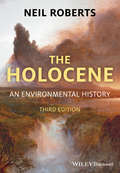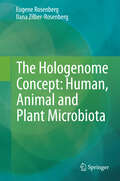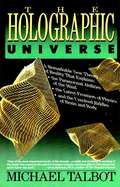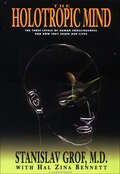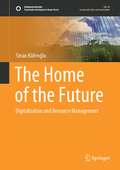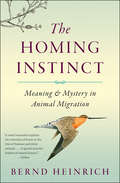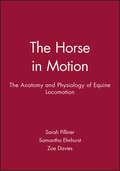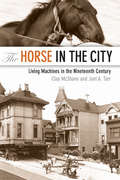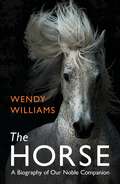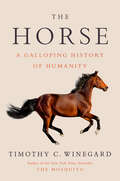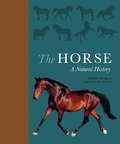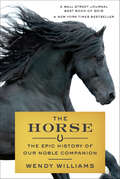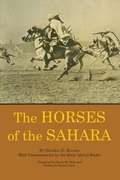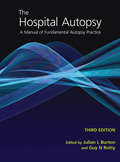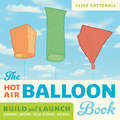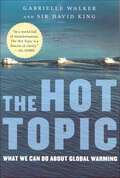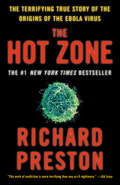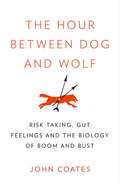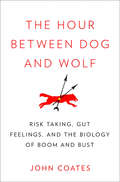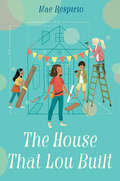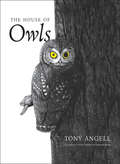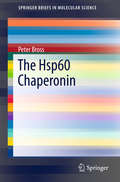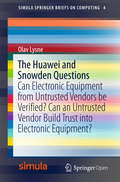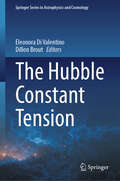- Table View
- List View
The Holocene: An Environmental History
by Neil RobertsThe Holocene provides students, researchers and lay-readers with the remarkable story of how the natural world has been transformed since the end of the last Ice Age around 15,000 years ago. This period has witnessed a shift from environmental changes determined by natural forces to those dominated by human actions, including those of climate and greenhouse gases. Understanding the environmental changes - both natural and anthropogenic - that have occurred during the Holocene is of crucial importance if we are to achieve a sustainable environmental future. Revised and updated to take full account of the most recent advances, the third edition of this classic text includes substantial material on the scientific methods that are used to reconstruct and date past environments, as well as new concepts such as the Anthropocene. The book is fully-illustrated, global in coverage, and contains case studies, a glossary and more than 500 new references.
The Hologenome Concept: Human, Animal and Plant Microbiota
by Eugene Rosenberg Ilana Zilber-RosenbergGroundbreaking research over the last 10 years has given rise to the hologenome concept of evolution. This concept posits that the holobiont (host plus all of its associated microorganisms) and its hologenome (sum of the genetic information of the host and its symbiotic microorganisms), acting in concert, function as a unique biological entity and therefore as a level of selection in evolution. All animals and plants harbor abundant and diverse microbiota, including viruses. Often the amount of symbiotic microorganisms and their combined genetic information far exceed that of their host. The microbiota with its microbiome, together with the host genome, can be transmitted from one generation to the next and thus propagate the unique properties of the holobiont. The microbial symbionts and the host interact in a cooperative way that affects the health of the holobiont within its environment. Beneficial microbiota protects against pathogens, provides essential nutrients, catabolizes complex polysaccharides, renders harmful chemicals inert, and contributes to the performance of the immune system. In humans and animals, the microbiota also plays a role in behavior. The sum of these cooperative interactions characterizes the holobiont as a unique biological entity. Genetic variation in the hologenome can be brought about by changes in either the host genome or the microbial population genomes (microbiome). Evolution by cooperation can occur by amplifying existing microbes, gaining novel microbiota and by acquiring microbial and viral genes. Under environmental stress, the microbiome can change more rapidly and in response to more processes than the host organism alone and thus influences the evolution of the holobiont. Prebiotics, probiotics, synbiotics and phage therapy are discussed as applied aspects of the hologenome concept.
The Hologenome Concept: Human, Animal and Plant Microbiota
by Eugene Rosenberg Ilana Zilber-RosenbergGroundbreaking research over the last 10 years has given rise to the hologenome concept of evolution. This concept posits that the holobiont (host plus all of its associated microorganisms) and its hologenome (sum of the genetic information of the host and its symbiotic microorganisms), acting in concert, function as a unique biological entity and therefore as a level of selection in evolution.All animals and plants harbor abundant and diverse microbiota, including viruses. Often the amount of symbiotic microorganisms and their combined genetic information far exceed that of their host. The microbiota with its microbiome, together with the host genome, can be transmitted from one generation to the next and thus propagate the unique properties of the holobiont. The microbial symbionts and the host interact in a cooperative way that affects the health of the holobiont within its environment. Beneficial microbiota protects against pathogens, provides essential nutrients, catabolizes complex polysaccharides, renders harmful chemicals inert, and contributes to the performance of the immune system. In humans and animals, the microbiota also plays a role in behavior. The sum of these cooperative interactions characterizes the holobiont as a unique biological entity. Genetic variation in the hologenome can be brought about by changes in either the host genome or the microbial population genomes (microbiome). Evolution by cooperation can occur by amplifying existing microbes, gaining novel microbiota and by acquiring microbial and viral genes. Under environmental stress, the microbiome can change more rapidly and in response to more processes than the host organism alone and thus influences the evolution of the holobiont. Prebiotics, probiotics, synbiotics and phage therapy are discussed as applied aspects of the hologenome concept.
The Holographic Universe
by Michael TalbotThese relatively new data are of such far-reaching relevance that they could revolutionize our understanding of the human psyche, of psychopathology, and of the therapeutic process. Some of the observations transcend in their significance the framework of psychology and psychiatry and represent a serious challenge to the current Newtonian-Cartesian paradigm of Western science. They could change drastically our image of human nature, of culture and history, and of reality.
The Holotropic Mind: The Three Levels of Human Consciousness and How They Shape Our Lives
by Hal Zina Bennett Stanislav Grof“An exceptionally clear and readable introduction to the evolving psychology of the spirit, transpersonal psychology” from the renowned psychiatrist (Charles T. Tart, PhD, author of Mind Science).A turning point in psychology and human history . . . Loaded with case studies which present a unified model of human consciousness—a revolutionary map of the mind that explains our evolution, behavior, personality, and the mind-body connection—this work takes readers on a compelling journey into the mind, human behavior, and future of humankind.“If you want to know about the psychology of the future today, read this book. It is about a revolution in our understanding of the mind that is as far-reaching in psychology as the idea of the quantum was to physics.” —Fred Alan Wolf, PhD, author of Taking the Quantum Leap“Grof marshals an impressive array of data and speculation in support of the timely demand that Western science acknowledge consciousness and its many non-ordinary states.” —Ram Dass
The Home of the Future: Digitalization and Resource Management (Sustainable Development Goals Series)
by Sinan KüfeoğluThis book presents an in-depth study to show that a sustainable future urban life is possible. To build a safer and more sustainable future, as humankind, we would like to use more renewable energy, increase energy efficiency, reduce our carbon and water footprints in all economic sectors. The increasing population and humans’ ever-increasing demand for consumption pose another question whether the world’s resources are sufficient for present and future generations. Fair access to water, energy, and food is the objective for all. In line with the United Nations Sustainable Development Goals, scientists, researchers, engineers, and policymakers worldwide are working hard to achieve these objectives. To answer all these challenges, we would like to introduce the core of Smart Cities of the future, the building block of the future’s urban life: Open Digital Innovation Hub (ODIH). ODIH will serve as the ‘Home of the Future’, a fully digitalised and smart, self-sustaining building that answers all the motivation we highlight here. In ODIH, we introduce a living space that produces its water, energy, and food by minimising carbon and water footprints thanks to the Internet of Things, Artificial Intelligence, and Blockchain technologies. It will also serve as an open innovation environment for start-ups and entrepreneurs who wish to integrate their solutions into the infrastructure of ODIH and test those in real-time. We believe this will be a true open innovation test-bed for new business models.
The Homing Instinct: Meaning and Mystery in Animal Migration
by Bernd HeinrichA captivating exploration of the homing instinct in animals, and what it means for human happiness and survival, from the celebrated naturalist and author of Mind of the Raven, Why We Run, and Life Everlasting.Acclaimed scientist and author Bernd Heinrich has returned every year since boyhood to a beloved patch of western Maine woods. What is the biology in humans of this deep-in-the-bones pull toward a particular place, and how is it related to animal homing?Heinrich explores the fascinating science chipping away at the mysteries of animal migration: how geese imprint true visual landscape memory; how scent trails are used by many creatures, from fish to insects to amphibians, to pinpoint their home if they are displaced from it; and how the tiniest of songbirds are equipped for solar and magnetic orienteering over vast distances. Most movingly, Heinrich chronicles the spring return of a pair of sandhill cranes to their home pond in the Alaska tundra. With his trademark “marvelous, mind-altering” prose (Los Angeles Times), he portrays the unmistakable signs of deep psychological emotion in the newly arrived birds??—??and reminds us that to discount our own emotions toward home is to ignore biology itself.
The Horse in Motion: The Anatomy and Physiology of Equine Locomotion
by Sarah Pilliner Zoe Davies Samantha ElmhurstWe all want our horses to be able to perform to the best of their ability and we know that an effective training regime has many facets. The horse must be worked correctly, fed a balanced ration, mentally and physically healthy and well looked after. This book examines a further aspect of the horse's performance: it is designed to help all horse owners and riders to understand how a horse moves and how its anatomy helps, or hinders, the horse's athletic ability. First, the book uses sequences of photographs and detailed anatomical drawings to show the systems of support and movement at each phase of each of the horse's gaits. The walk, trot, canter, gallop and jump are all examined, and the effect of the rider on the horse evaluated so that the rider can take appropriate action to avoid hindering the horse. Tips are provided throughout on ways in which the horse's life can be made easier, such as saddle fitting, warming up and cooling down procedures.
The Horse in the City: Living Machines in the Nineteenth Century (Animals, History, Culture)
by Clay McShane Joel TarrHonorable mention, 2007 Lewis Mumford Prize, American Society of City and Regional PlanningThe nineteenth century was the golden age of the horse. In urban America, the indispensable horse provided the power for not only vehicles that moved freight, transported passengers, and fought fires but also equipment in breweries, mills, foundries, and machine shops.Clay McShane and Joel A. Tarr, prominent scholars of American urban life, here explore the critical role that the horse played in the growing nineteenth-century metropolis. Using such diverse sources as veterinary manuals, stable periodicals, teamster magazines, city newspapers, and agricultural yearbooks, they examine how the horses were housed and fed and how workers bred, trained, marketed, and employed their four-legged assets. Not omitting the problems of waste removal and corpse disposal, they touch on the municipal challenges of maintaining a safe and productive living environment for both horses and people and the rise of organizations like the American Society for the Prevention of Cruelty to Animals. In addition to providing an insightful account of life and work in nineteenth-century urban America, The Horse in the City brings us to a richer understanding of how the animal fared in this unnatural and presumably uncomfortable setting.
The Horse: A Biography of Our Noble Companion
by Wendy WilliamsHorses have been immensely helpful to mankind through history; we've used them for work, transport, and sport. They even played a key role in confirming and then refining Darwin's theory of evolution. But do they get anything out of this relationship with us? And what would have happened if we'd simply left them alone?Williams traces the history of the horse from its origins to the present day. She explores the horse-human relationship through history, taking us from Solutre, where thousands of horses were butchered, through to their domestic relationship with us which began 6,000 years ago. The Horse is a search for an answer to the question of what it's like to be a horse, ending with a look ahead to what the future holds for humans and equines.
The Horse: A Galloping History of Humanity
by Timothy C. WinegardFrom New York Times bestselling author of The Mosquito, the incredible story of how the horse shaped human historyTimothy C. Winegard&’s The Horse is an epic history unlike any other. Its story begins more than 5,500 years ago on the windswept grasslands of the Eurasian Steppe; when one human tamed one horse, an unbreakable bond was forged and the future of humanity was instantly rewritten, placing the reins of destiny firmly in human hands.Since that pivotal day, the horse has carried the history of civilizations on its powerful back. For millennia it was the primary mode of transportation, an essential farming machine, a steadfast companion, and a formidable weapon of war. Possessing a unique combination of size, speed, strength, and stamina, the horse dominated every facet of human life and shaped the very scope of human ambition. And we still live among its galloping shadows.Horses revolutionized the way we hunted, traded, traveled, farmed, fought, worshipped, and interacted. They fundamentally reshaped the human genome and the world&’s linguistic map. They determined international borders, molded cultures, fueled economies, and built global superpowers. They decided the destinies of conquerors and empires. And they were vectors of lethal disease and contributed to lifesaving medical innovations. Horses even inspired architecture, invention, furniture, and fashion. From the thundering cavalry charges of Alexander the Great to the streets of New York during the Great Manure Crisis of 1894 and beyond, horses have shaped both the grand arc of history and our everyday lives.Driven by fascinating revelations and fast-paced storytelling, The Horse is a riveting narrative of this noble animal&’s unrivaled and enduring reign across human history. To know the horse is to understand the world.
The Horse: A Natural History
by Debbie Busby Professor Catrin RutlandA comprehensive, richly illustrated introduction to the fascinating natural history of the horse, from prehistory to the presentThere are countless books about keeping and riding horses. The Horse is different: it looks not only at the natural history of the horse in the context of its use by humans, but also at its own, independent story, describing the way horses live, think, and behave both alongside people and on their own. Beautifully designed and illustrated, The Horse provides an engaging and accessible introduction to these beloved animals.Beginning with evolution and development, The Horse tells how horses came into being more than fifty million years ago and were first domesticated more than five thousand years ago, eventually spreading across the globe. Chapters on Anatomy & Biology and Society & Behavior explain equine anatomy and how it has affected the lives and social structure of horses, and outline current scientific thinking on their behavior as individual and herd animals, including information on communication between horses. A chapter on Horses & People provides a thorough overview of the horse’s many important roles in human history and today, from pack animal to sporting champion. Finally, the book ends with an engrossing and visually stunning photographic gallery of some fifty popular breeds of horses and ponies with essential information about each.Filled with surprising facts and insights, this book will delight anyone who loves horses and wants to understand them better.Provides a comprehensive, richly illustrated introduction to the evolution, development, domestication, and behavior of the horse—from life cycle, breeding, coats and colors, and the senses to courtship, parenting, communication, emotions, and learningTells the full story of horses, from their earliest fossil ancestors to the modern-day EquusOffers a detailed survey of how horses and humans have interacted since horses were domesticated, including their use for work and war in the past and recreational and competitive riding todayFeatures infographics, diagrams, and more than 250 stunning color photographsIncludes a beautiful photographic directory to some 50 popular breeds
The Horse: The Epic History of Our Noble Companion
by Wendy WilliamsThe New York Times bestseller: “Lifelong equestrian enthusiast Williams takes on the topic at full gallop . . . [a] lively, fascinating read.” —DiscoverA Best Book of 2015, The Wall Street JournalA New York Times Book Review Editors’ ChoiceJournalist and equestrienne Wendy Williams chronicles the 56-million-year journey of horses as she visits with experts around the world, exploring what our biological affinities and differences can tell us about the bond between horses and humans, and what our longtime companion might think and feel. Indeed, recent scientific breakthroughs regarding the social and cognitive capacities of the horse and its ability to adapt to changing ecosystems indicate that this animal is a major evolutionary triumph.Williams charts the course that leads to our modern Equus-from the protohorse to the Dutch Warmbloods, Thoroughbreds, and cow ponies of the twenty-first century. She observes magnificent ancient cave art in France and Spain that signals a deep respect and admiration for horses well before they were domesticated; visits the mountains of Wyoming with experts in equine behavior to understand the dynamics of free-roaming mustangs; witnesses the fluid gracefulness of the famous Lipizzans of Vienna; contemplates what life is like for the sure-footed, mustachioed Garrano horses who thrive on the rugged terrain of Galicia; meets a family devoted to rehabilitating abandoned mustangs on their New Hampshire farm; celebrates the Takhi horses of Mongolia; and more. She blends profound scientific insights with remarkable stories to create a unique biography of the horse as a sentient being with a fascinating past and a finely nuanced mind.
The Horses of the Sahara
by General E. Daumas Sheila M. OhlendorfGeneral Daumas took part in the conquest of Algeria by France, so distinguishing himself that he was named Director of the Bureau of Algerian Affairs in the French Ministry of War. During the campaigns and the occupation that followed, he studied and attempted to understand the native peoples, with an objectivity and sympathy unusual among the colonialists of the period. His book provides fascinating sidelights on many aspects of Arab life, including customs, superstitions, religion, and family life.
The Hospital Autopsy: A Manual of Fundamental Autopsy Practice, Third Edition
by Guy Rutty Julian BurtonNow in full colour, this new and revised edition of The Hospital Autopsy presents a clear and systematic approach to safe and effective modern autopsy practice for pathologists. It begins by discussing issues such as legislation governing autopsies, religious attitudes and ensuring safety, before covering the procedures of external examination, evi
The Hot Air Balloon Book: Build and Launch Kongming Lanterns, Solar Tetroons, and More (Science in Motion)
by Clive CatterallWith detailed, step-by-step instructions, this richly illustrated science project book shows how to construct and safely launch homemade balloons. Some designs, including the Solar Tetroon or the Giant Solar Sausage, are made from garbage bags and tape, while others, such as the Khom Loi, are created from tissue paper and wire; yet all of the projects use inexpensive, readily available materials and are easy to construct with only basic crafting skills. Ever safety conscious, this manual provides detailed guidelines for various methods to heat the interior air that lifts the balloons, including when and where open flames are appropriate, and the proper weather conditions to launch these creations. With a full chapter on troubleshooting, should a design fail to fly, this book will make balloon engineers of just about anyone.
The Hot Topic: What We Can Do about Global Warming
by Gabrielle Walker David KingOne of the most dynamic writers and one of the most respected scientists in the field of climate change offer the first concise guide to both the problems and the solutions of global warming. Guiding us past a blizzard of information and misinformation, Gabrielle Walker and Sir David King explain the science of warming, the most cutting-edge technological solutions from small to large, and the national and international politics that will affect our efforts. While there have been many other books about the problem of global warming, none has addressed what we can and should do about it so clearly and persuasively, with no spin, no agenda, and no exaggeration. Neither Walker nor King is an activist or politician, and theirs is not a generic green call to arms. Instead they propose specific ideas to fix a very specific problem. Most important, they offer hope: This is a serious issue, perhaps the most serious that humanity has ever faced. But we can still do something about it. And they’ll show us how.
The Hot Zone: The Terrifying True Story of the Origins of the Ebola Virus (Large Print Bks.)
by Richard PrestonThe bestselling landmark account of the first emergence of the Ebola virus. Now a mini-series drama starring Julianna Margulies, Topher Grace, Liam Cunningham, James D'Arcy, and Noah Emmerich on National Geographic.A highly infectious, deadly virus from the central African rain forest suddenly appears in the suburbs of Washington, D.C. There is no cure. In a few days 90 percent of its victims are dead. A secret military SWAT team of soldiers and scientists is mobilized to stop the outbreak of this exotic "hot" virus. The Hot Zone tells this dramatic story, giving a hair-raising account of the appearance of rare and lethal viruses and their "crashes" into the human race. Shocking, frightening, and impossible to ignore, The Hot Zone proves that truth really is scarier than fiction.
The Hour Between Dog and Wolf
by John CoatesA successful Wall Street trader turned Cambridge neuroscientist reveals the biology of financial boom and bust, showing how risk-taking transforms our body chemistry, driving us to extremes of euphoria or stressed-out depression. The laws of financial boom and bust, it turns out, have a lot to do with male hormones. In a series of startling experiments, Canadian scientist Dr. John Coates identified a feedback loop between testosterone and success that dramatically lowers the fear of risk in men, especially young men; he has vividly dubbed the moment when traders transform into exuberant high flyers "the hour between dog and wolf." Similarly, intense failure leads to a rise in levels of cortisol, which dramatically lowers the appetite for risk. His book expands on his seminal research to offer lessons from the exploding new field studying the biology of risk. Coates's conclusions shed light on all types of high-pressure decision-making, from the sports field to the battlefield, and leaves us with a powerful recognition: to handle risk isn't a matter of mind over body, it's a matter of mind and body working together. We all have it in us to be transformed from dog to wolf; the only question is whether we can understand the causes and the consequences.
The Hour Between Dog and Wolf: How Risk Taking Transforms Us, Body and Mind
by John CoatesA successful Wall Street trader turned Cambridge neuroscientist reveals the biology of financial boom and bust, showing how risk-taking transforms our body chemistry, driving us to extremes of euphoria or stressed-out depression. The laws of financial boom and bust, it turns out, have a lot to do with male hormones. In a series of startling experiments, Canadian scientist Dr. John Coates identified a feedback loop between testosterone and success that dramatically lowers the fear of risk in men, especially young men; he has vividly dubbed the moment when traders transform into exuberant high flyers "the hour between dog and wolf. " Similarly, intense failure leads to a rise in levels of cortisol, which dramatically lowers the appetite for risk. His book expands on his seminal research to offer lessons from the exploding new field studying the biology of risk. Coates's conclusions shed light on all types of high-pressure decision-making, from the sports field to the battlefield, and leaves us with a powerful recognition: to handle risk isn't a matter of mind over body, it's a matter of mind and body working together. We all have it in us to be transformed from dog to wolf; the only question is whether we can understand the causes and the consequences.
The House That Lou Built
by Mae RespicioA coming-of-age story that explores culture and family, forgiveness and friendship, and what makes a true home. Perfect for fans of Wendy Mass and Joan Bauer. <P><P>Lou Bulosan-Nelson has the ultimate summer DIY project. She's going to build her own "tiny house," 100 square feet all her own. She shares a room with her mom in her grandmother's house, and longs for a place where she can escape her crazy but lovable extended Filipino family. <P><P>Lou enjoys her woodshop class and creating projects, and she plans to build the house on land she inherited from her dad, who died before she was born. <P><P>But then she finds out that the land may not be hers for much longer. Lou discovers it's not easy to save her land, or to build a house. But she won't give up; with the help of friends and relatives, her dream begins to take shape, and she learns the deeper meaning of home and family.
The House of Owls
by Tony Angell&“A charming personal account, accompanied by nearly 100 illustrations, that underscores how owls and other birds enrich our lives.&”—Kirkus Reviews Winner of the National Outdoor Book Award For a quarter of a century, Tony Angell and his family shared the remarkable experience of closely observing pairs of western screech owls that occupied a nesting box outside the window of their forest home. The journals in which the author recorded his observations, and the captivating drawings he created, form the heart of this compelling book—a personal account of an artist-naturalist&’s life with owls. Angell&’s extensive illustrations show owls engaged in what owls do—hunting, courting, raising families, and exercising their inquisitive natures—and reveal his immeasurable respect for their secret lives and daunting challenges. Angell discusses the unique characteristics that distinguish owls from other bird species and provides a fascinating overview of the impact owls have had on human culture and thought. He also offers detailed scientific descriptions of the nineteen species of owls found in North America, as well as their close relatives elsewhere. Always emphasizing the interaction of humans and owls, the author affirms the power of these birds to both beguile and inspire. &“Endearing…provides a lot of fascinating information about these reclusive creatures.&”—The New York Times Book Review &“Angell writes (and draws) with the absolute authority of one who has studied, rehabilitated, lived with and loved the animals his whole life.&”—The Wall Street Journal &“Steeped in the tradition of Alexander Wilson and John James Audubon, it blends taxonomy, ornithology, biogeography and autobiography.&”—Times Literary Supplement
The Hsp60 Chaperonin
by Peter BrossIn this unique overview of the Hsp60 chaperonin, Peter Bross addresses molecular biologists, medical research scientists and individuals interested in molecular or general biology. First, Bross discusses the basics of the Hsp60 chaperonin in terms of its structure and the molecular mechanisms determining its function. Second, the author highlights the multiple roles of Hsp60 for cellular systems and regulatory pathways, especially in connection with neurodegenerative diseases caused by Hsp60 deficiency. Finally, the author highlights controversial observations suggesting additional, non-standard functions of Hsp60 in and outside mitochondria as well as possible gaps in our understanding of the chaperonin. This volume serves as a snapshot suitable for experienced researcher working in fields related to molecular chaperones yet still accessible to researchers entering the field.
The Huawei and Snowden Questions
by Olav LysneThis open access book answers two central questions: firstly, is it at all possible to verify electronic equipment procured from untrusted vendors? Secondly, can I build trust into my products in such a way that I support verification by untrusting customers? In separate chapters the book takes readers through the state of the art in fields of computer science that can shed light on these questions. In a concluding chapter it discusses realistic ways forward. In discussions on cyber security, there is a tacit assumption that the manufacturer of equipment will collaborate with the user of the equipment to stop third-party wrongdoers. The Snowden files and recent deliberations on the use of Chinese equipment in the critical infrastructures of western countries have changed this. The discourse in both cases revolves around what malevolent manufacturers can do to harm their own customers, and the importance of the matter is on par with questions of national security.This book is of great interest to ICT and security professionals who need a clear understanding of the two questions posed in the subtitle, and to decision-makers in industry, national bodies and nation states.
The Hubble Constant Tension (Springer Series in Astrophysics and Cosmology)
by Eleonora Di Valentino Dillon BroutThis book presents the first comprehensive exploration of the state of this well studied and thus unsolved mystery of the value of the Hubble constant. Chapters covering data, systematics, independent methodologies, and theoretical explanations are authored by distinguished subject-matter experts. Tailored for scientists in the field or adjacent fields, this book provides a resource of insights and also an in-depth background sufficient for motivating future study. Key Features: Introduction: Written by the Nobel Laureate Adam Riess. Measurement Techniques: Gain a profound understanding of the leading Hubble constant measurement techniques, from parallax and masers to supernovae and cosmic chronometers, dissected by leading authorities on each. Systematic Errors: A deep dive into the complexities of data. Experts scrutinize potential sources of systematics that may contribute to the observed disagreements, offering a nuanced view of the challenges in Hubble constant determinations. Theoretical Explanations and Progress: A review of the theoretical explanations, some that are still standing, and some that have been ruled out; all of which have led to scientific progress toward the truth. A Comprehensive Take: This book covers every key and influential aspect to the dilemma of the Hubble tension to date and has gathered world-leading voices on each respective topic.
